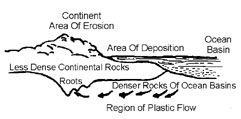
A D I V I S I O N O F E K L A V Y A E D U C A T I O N F O U N D A T I O N
| Code: TLM-Sc-004 | Age: 9-16 yrs | Name: Geology Demonstration Kit |
| they are composed of less dense rocks. If materials (sediments) are removed from a mountainous area by erosion and are deposited in an adjacent shallow sea, the areas are no longer balanced and the highland will slowly rise and the lowland will sink as they adjust to the new conditions. These movements or adjustments probably take place ad depth where the rocks are under great pressure and can flow plastically. The following diagram shows these relationships in a generalized fashion. 
ACTIVITY TO DEMONSTRATE ISOSTASY
Carefully place sand from the "highland" block onto the "lowland" block. Notice how the level of the "highland" block rises as sand (eroded materials) is removed and placed on the "lowland" block. Note also the compensatory movement of the "lowland" block. It sinks as sand (sediments) is placed upon it. |
Discussion:
2. Fold the foam pieces as shown and label them 1, 2 and 3 as before. Point out to the class that now the oldest rock layer (3) rests on top of a younger rock layer (2) and layer 2 on top of 1. This situation occurs when rock units are overturned as shown by the foam pieces. |

